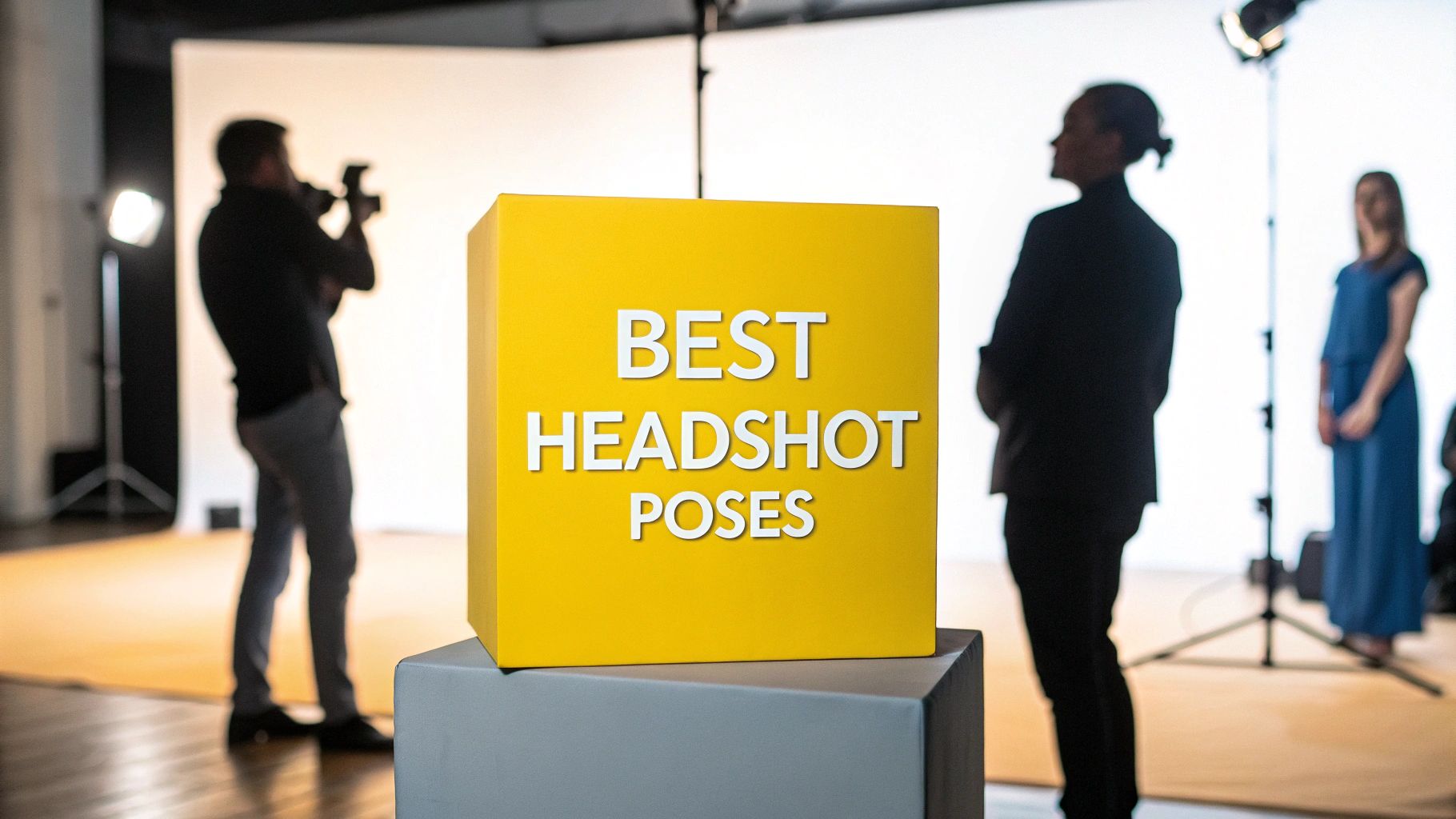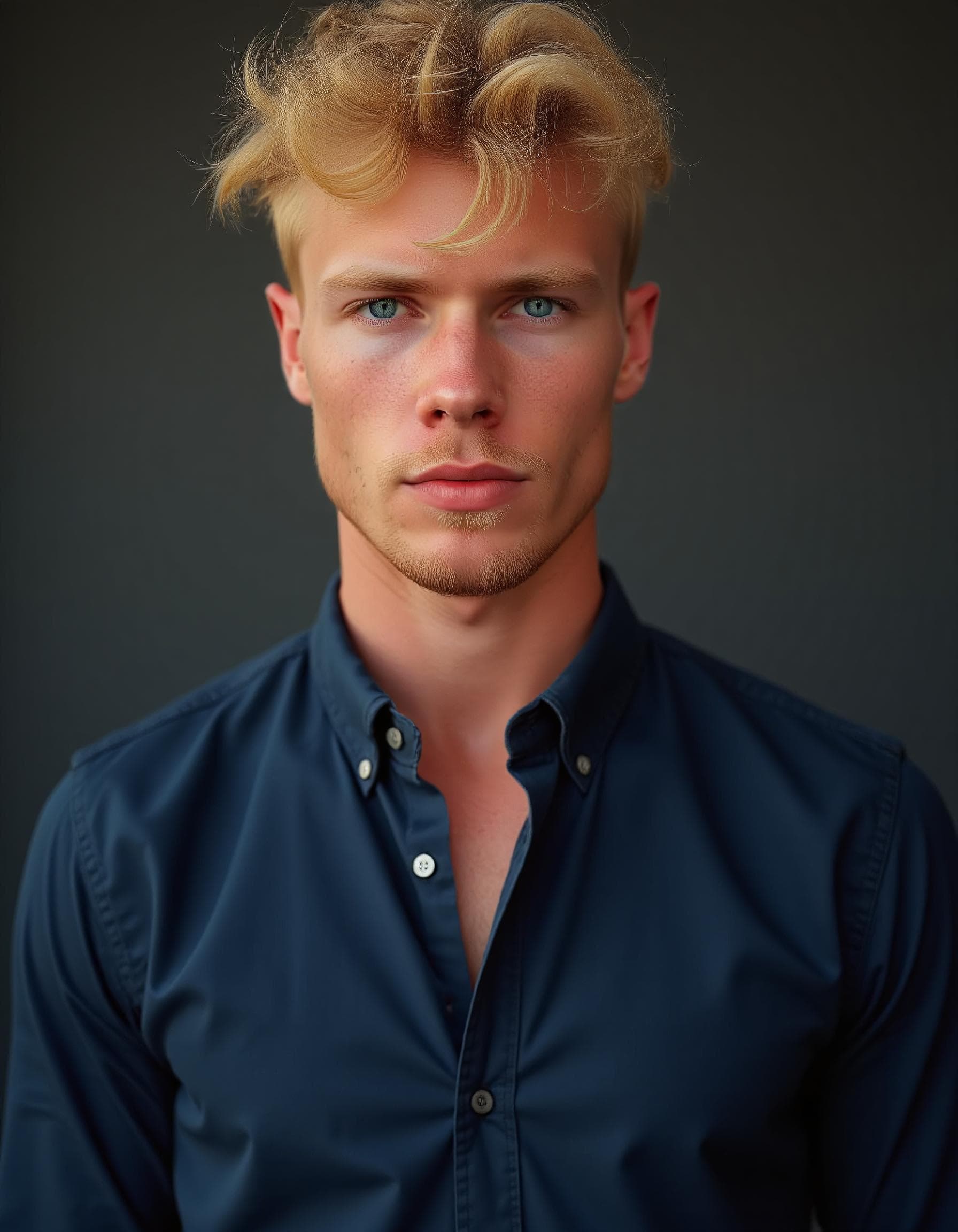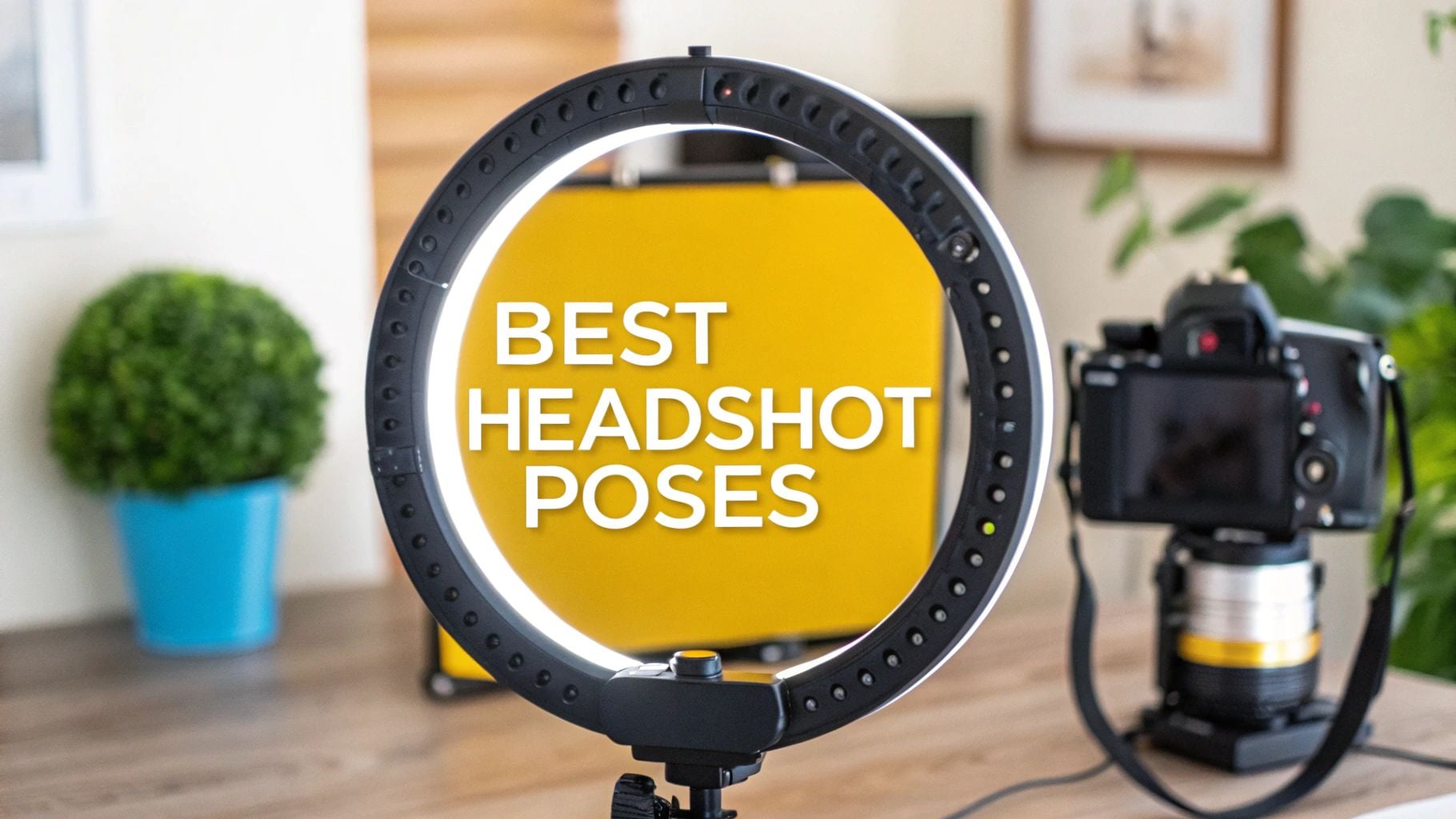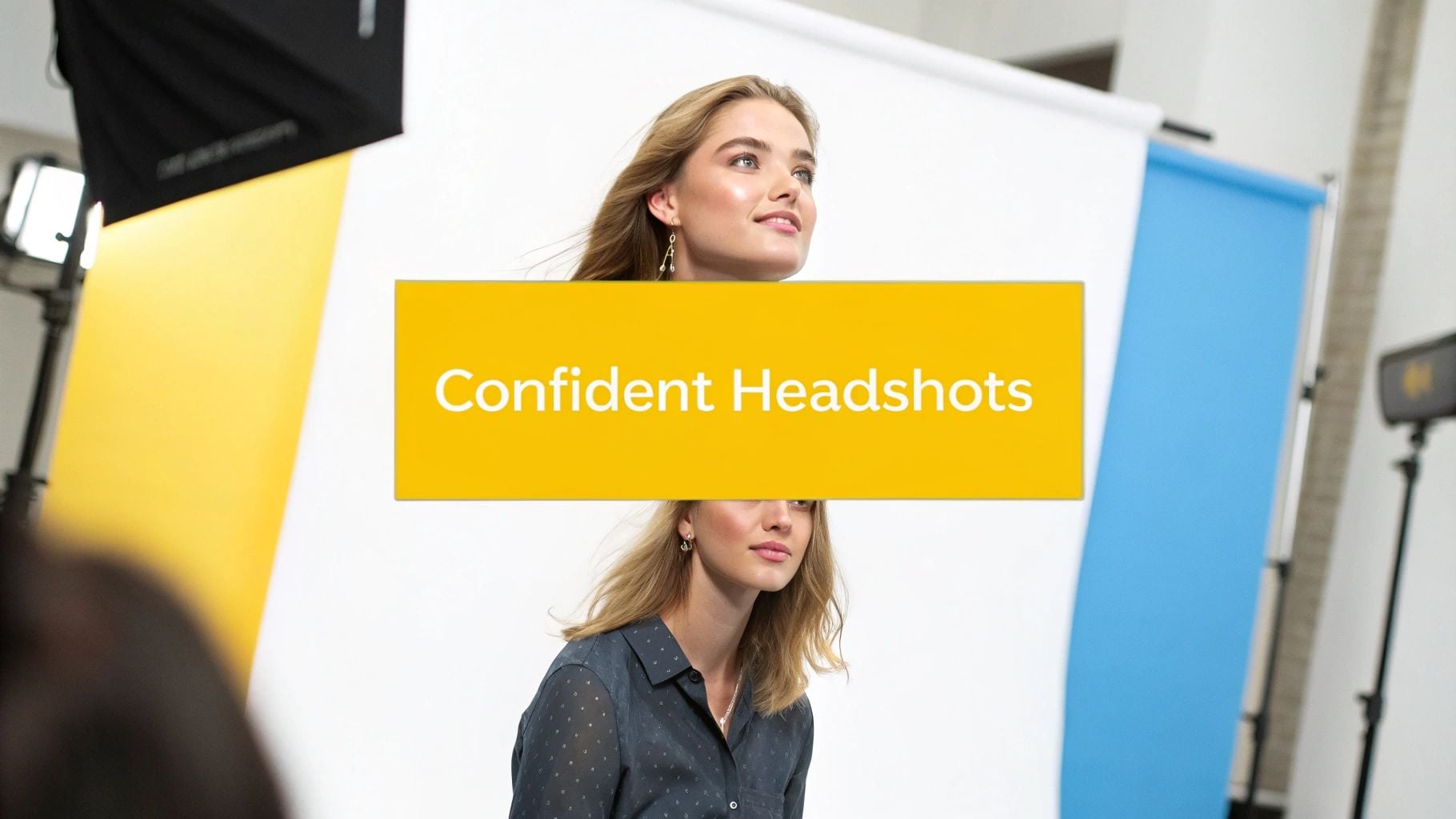Your headshot is often your first introduction to potential employers, clients, and colleagues. For professionals, job seekers, and remote workers, a compelling profile picture on platforms like LinkedIn can make all the difference, immediately conveying competence and personality. But achieving that perfect shot goes beyond good lighting and a sharp outfit; it's about finding the right pose that communicates confidence and approachability.
A great pose feels natural and authentic, not stiff or forced.
Whether you're preparing for a traditional photoshoot or exploring modern solutions like AI-generated headshots, understanding the fundamentals of posing is key to presenting your best self. While perfecting your stance and expression, remember that a professional headshot also benefits from a well-groomed appearance. Explore options for the best hair styling products to ensure every detail is polished and professional.
This guide breaks down the best poses for headshots, offering actionable tips to help you create a portrait that truly represents your personal brand. From subtle shifts in posture to strategic hand placements, you'll learn how to master seven essential poses that project confidence, warmth, and professionalism, ensuring you make a memorable first impression every time.
1. The Classic Forward Lean
The Classic Forward Lean is a foundational technique in portrait photography and one of the best poses for headshots because of its ability to create an immediate sense of connection and engagement. This pose involves the subject subtly leaning their upper body toward the camera from the waist or hips. The movement closes the distance between the subject and the viewer, making the final image feel more intimate and direct. It’s a powerful non-verbal cue that communicates confidence, interest, and approachability.
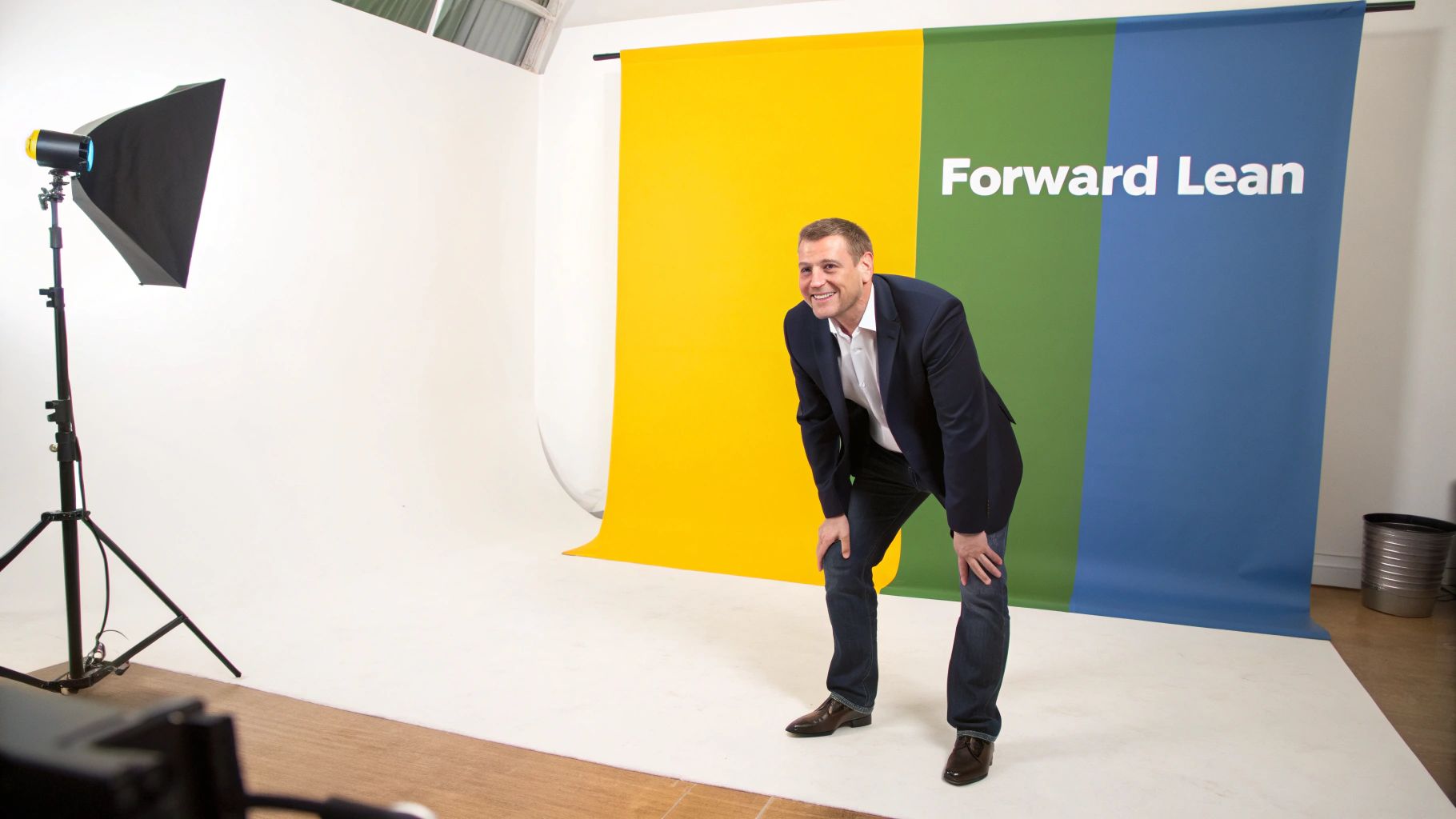
This pose is incredibly versatile, making it ideal for LinkedIn executive portraits, dynamic actor headshots, and marketing materials for professionals like real estate agents or consultants. The technique is designed to eliminate the passive, flat appearance that can occur when someone stands perfectly straight.
Why This Pose Works
The forward lean is effective for several key reasons. First, it brings the face slightly forward, subtly accentuating the jawline and minimizing the appearance of a double chin. Second, this forward motion creates a sense of depth, separating the subject from the background and adding a dynamic, three-dimensional quality to the portrait. Most importantly, it conveys an active, engaged posture that draws the viewer in.
Key Insight: Leaning in is a universal sign of interest and attentiveness. By incorporating this into your headshot, you are subconsciously telling the viewer, "I am engaged and confident."
How to Master the Classic Forward Lean
Achieving a natural-looking lean requires practice and attention to detail. Follow these actionable tips:
- Lean from the Hips: Ensure the lean is initiated from your hips or waist, not just by hunching your shoulders. This maintains good posture.
- Keep it Subtle: The movement should be slight, just a few inches forward is enough to make a significant impact without looking awkward or aggressive.
- Relax Your Shoulders: Avoid tension. Keep your shoulders down and relaxed to project an image of calm confidence.
- Push Your Forehead Out: A common cue from photographers is to imagine a string pulling your forehead gently toward the lens. This helps achieve the right angle and elongates the neck.
This classic pose is a staple in professional photography, but you don't need a physical photoshoot to achieve it. AI-powered tools can generate polished headshots incorporating this and other effective poses, providing a professional look with digital convenience.
2. The Angled Profile Turn
The Angled Profile Turn is one of the best poses for headshots for creating a sophisticated and dimensional portrait. This technique involves positioning the body at an approximate 45-degree angle to the camera while turning the face back toward the lens. This creates a visually interesting composition that adds depth, slims the silhouette, and accentuates the subject’s facial features without losing the crucial connection with the viewer. It strikes a perfect balance between a formal profile and a direct-to-camera shot.
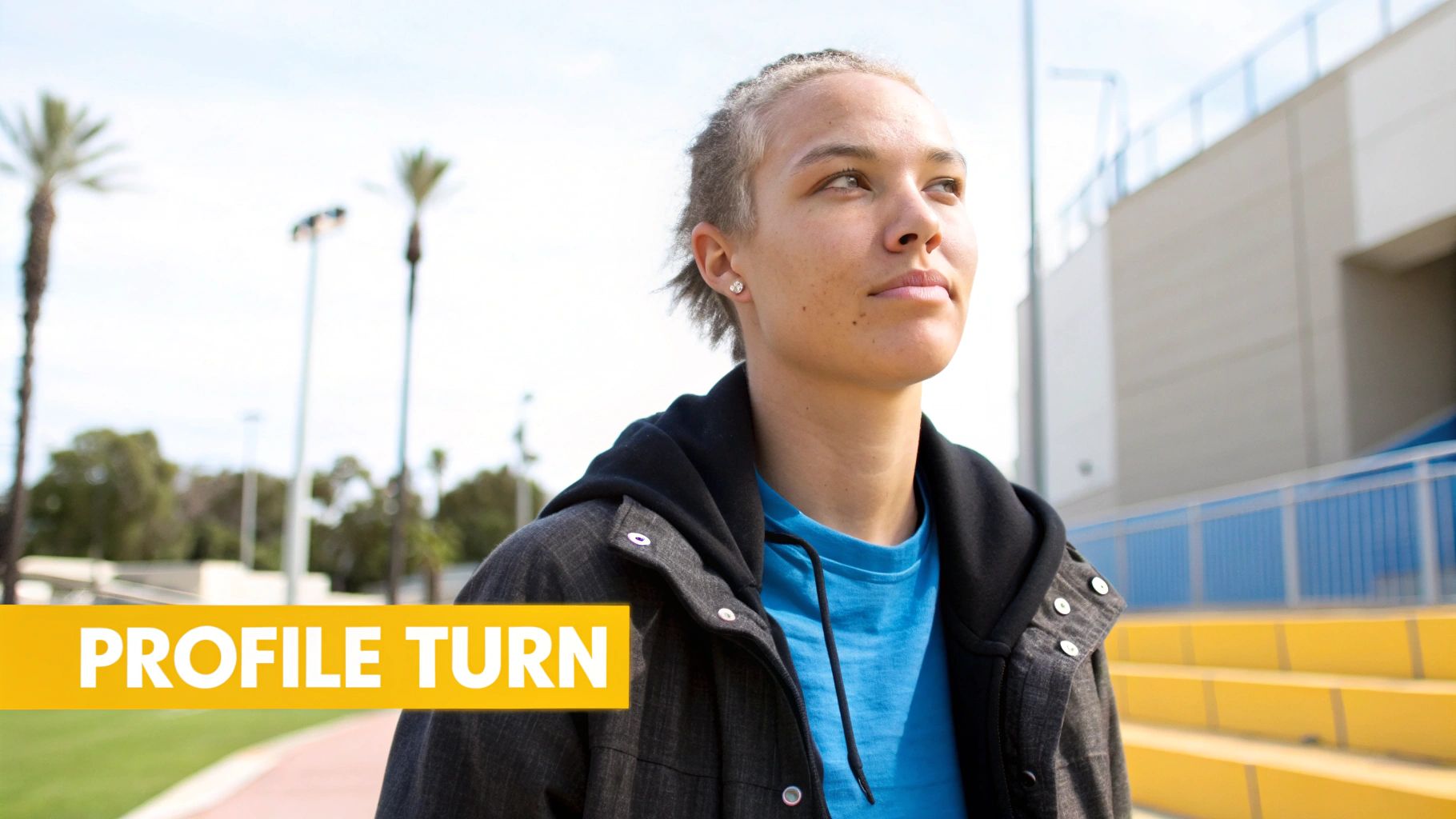
This pose conveys authority and thoughtfulness, making it a go-to choice for executive portraits, medical professionals, and law firm partners. This angle adds a layer of elegance and compositional strength, moving beyond a simple, straight-on photograph to create something more compelling and artistic.
Why This Pose Works
The Angled Profile Turn is effective because it uses leading lines and angles to guide the viewer’s eye. Angling the body creates a slimming effect and introduces a sense of dynamic structure to the image. By turning the face back to the camera, the subject maintains a strong, engaging connection, ensuring the portrait feels personal yet poised. This juxtaposition of the body’s angle and the directness of the gaze projects both confidence and accessibility.
Key Insight: Positioning your body at an angle while facing the camera creates a powerful dynamic. It suggests you are approachable and direct, yet also highlights a formal, professional posture.
How to Master the Angled Profile Turn
To execute this pose effectively, focus on subtle adjustments and maintaining a natural posture. Follow these actionable tips:
- Angle Your Body: Stand with your feet pointed about 45 degrees away from the camera. Let your hips and shoulders follow this angle naturally.
- Turn Your Head: Gently turn your head back toward the camera until you can comfortably make eye contact with the lens. Ensure both eyes are clearly visible.
- Lower Your Front Shoulder: Slightly drop the shoulder closest to the camera. This small adjustment elongates the neck and creates a more relaxed, flattering line.
- Maintain Eye Contact: The power of this pose comes from the direct gaze. Keep your eyes locked on the lens to build a strong connection with the viewer.
While traditionally captured in a studio, this sophisticated look is now easily achievable with modern technology. AI headshot generators can produce high-quality portraits featuring this and other classic poses, offering professionals a convenient way to get a polished look.
3. The Relaxed Sitting Position
The Relaxed Sitting Position is one of the best poses for headshots because it captures subjects in a comfortable, seated posture that projects both confidence and accessibility. This pose involves the subject sitting down, often leaning back slightly in a chair or against a surface, creating a look that is professional yet conversational. It moves away from the formality of standing poses, inviting a sense of ease and genuine personality into the portrait.
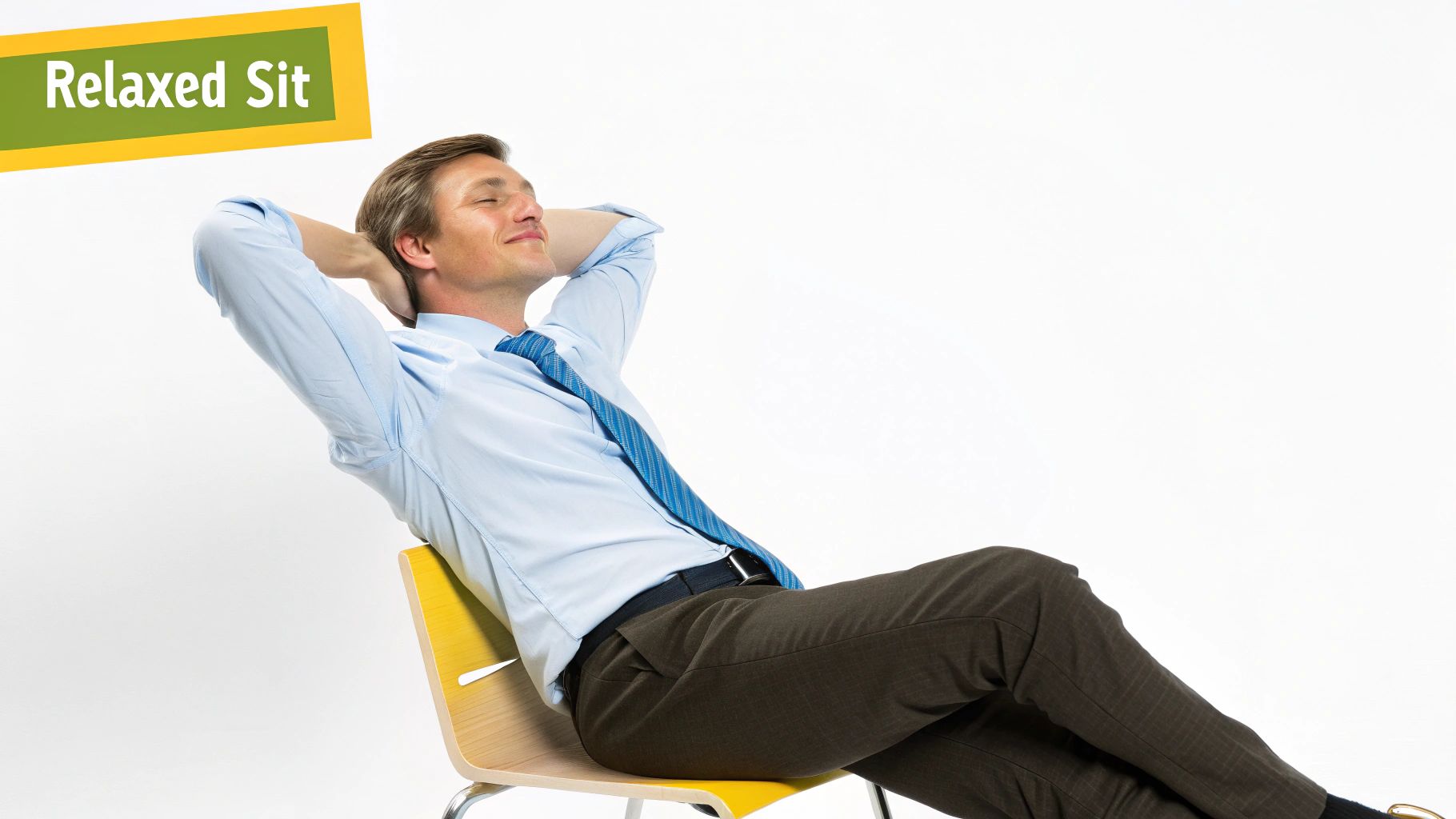
This pose is incredibly effective for professionals who want their headshot to feel approachable and authentic, such as therapists, consultants, academic professionals, and creative leaders. This seated pose helps to humanize the subject, making them appear more relatable to their audience on platforms like LinkedIn or a company website.
Why This Pose Works
The power of the Relaxed Sitting Position lies in its ability to communicate calm authority. Sitting naturally reduces physical tension, which translates to a more relaxed facial expression and body language. This pose grounds the subject in their environment, suggesting stability and thoughtfulness. By breaking the traditional upright mold, it creates a dynamic composition that is both engaging and disarming, allowing the subject's personality to shine through.
Key Insight: A seated position can make you appear more grounded, thoughtful, and open to conversation. It signals that you are comfortable and in control of your element.
How to Master the Relaxed Sitting Position
To achieve a polished and natural look, focus on subtle adjustments and maintaining good posture. Follow these actionable tips for an effective seated headshot:
- Maintain a Straight Spine: Even while leaning back or relaxing, keep your spine elongated to avoid slouching. Imagine a string pulling the crown of your head upward.
- Keep Feet Flat on the Floor: This provides a stable base, which helps you relax your upper body and feel more grounded throughout the session.
- Position Arms Naturally: Rest your hands on your lap, the armrests, or a desk. Avoid stiffly placing them or crossing them too tightly, which can look defensive.
- Choose the Right Chair: Use a chair that complements your height and the desired aesthetic. A simple stool, an office chair, or a modern armchair can each create a different mood.
While traditionally captured in a studio, achieving this composed look is also possible without a physical photoshoot. Advanced AI headshot generators can create professional portraits that incorporate the relaxed sitting pose, providing a convenient way to get a high-quality, approachable image.
4. The Confident Arms Crossed
The Confident Arms Crossed pose is a classic in professional portraiture, often used to convey authority, self-assurance, and leadership. This pose involves crossing the arms over the chest, which, when executed correctly, creates a powerful and decisive impression. While sometimes misinterpreted as defensive, a skilled photographer or subject can use this stance to project stability and expertise without sacrificing approachability. The key lies in balancing the strong body language with a warm, open facial expression.
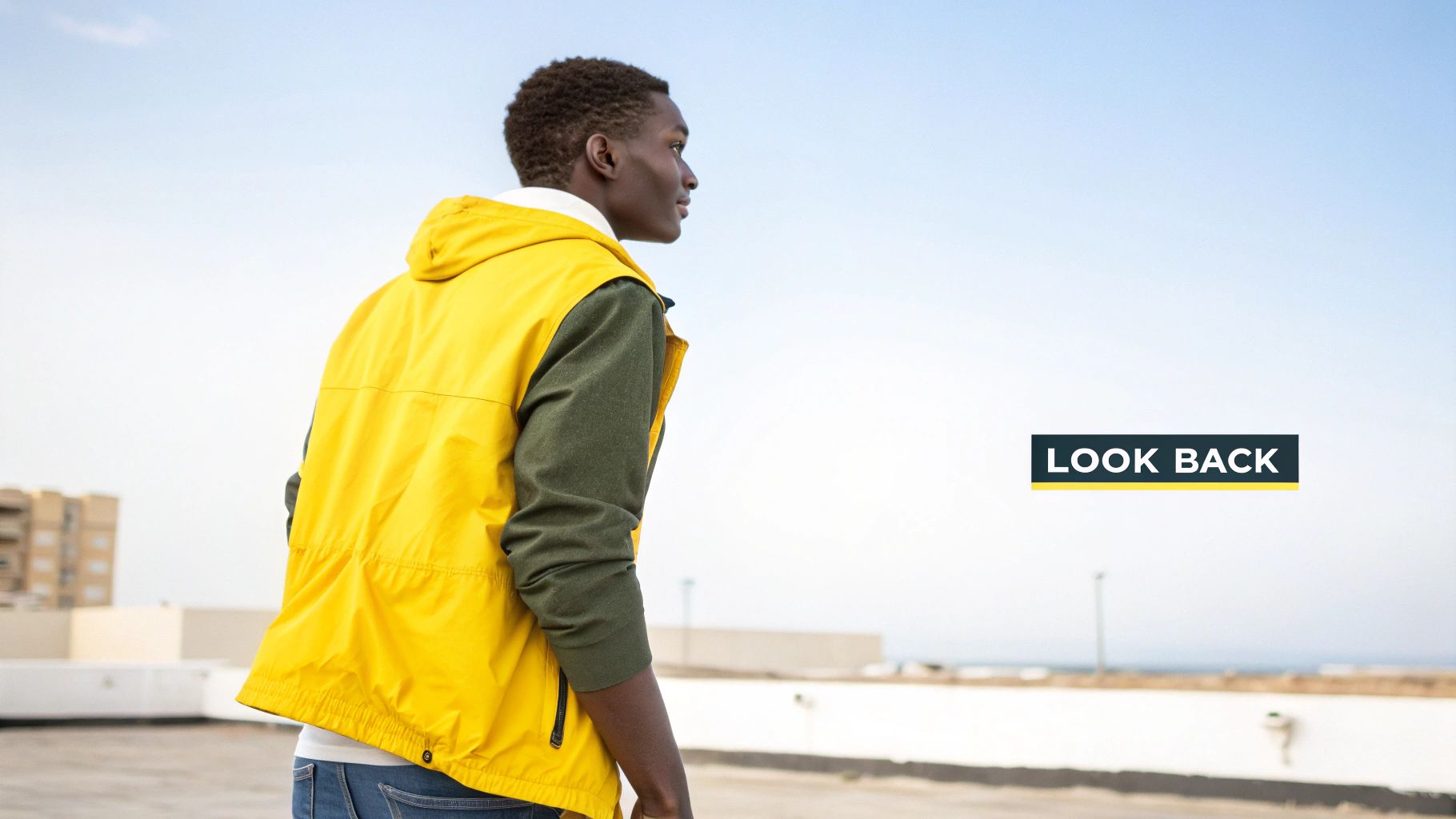
This pose is particularly effective for individuals in leadership roles, such as CEOs, executives, and consultants, and is frequently seen on business magazine covers and in corporate team photos. The structured nature of the pose frames the upper body, drawing attention to the subject’s confident demeanor.
Why This Pose Works
The effectiveness of the crossed-arms pose stems from its psychological impact. It projects an image of someone who is in control, resolute, and an expert in their field. This non-verbal cue can establish credibility and command respect. By creating a solid, grounded base, the pose makes the subject appear more formidable and centered, which is ideal for professional contexts where authority is a key attribute. It’s a definitive statement of confidence and one of the best poses for headshots meant to establish a strong professional brand.
Key Insight: Crossing your arms can project power and containment. When paired with a warm smile, it tells the viewer, "I am confident and in control, but also open and approachable."
How to Master The Confident Arms Crossed
To avoid looking closed-off or tense, mastering this pose requires attention to subtle details. Follow these actionable tips for a powerful yet inviting headshot:
- Relax Your Grip: Don't clench your fists or grip your arms tightly. Keep your hands and arms relaxed to project ease and comfort.
- Maintain a Warm Expression: The most critical element is your face. A genuine smile or a friendly, engaging expression is essential to offset the pose's inherent power.
- Keep Shoulders Down: Avoid hunching. Pull your shoulders back and down to maintain an open and confident posture, which also elongates your neck.
- Angle Your Body: Turn your body slightly to the side instead of facing the camera head-on. This adds depth and a more dynamic feel to the image.
Achieving the perfect balance in a pose like this can be challenging, but AI headshot generators can create a variety of options incorporating this and other poses, ensuring your final image is both powerful and professional. Learn more about effective business photo poses to enhance your professional image.
5. The Natural Hand Placement
The Natural Hand Placement is a sophisticated technique that introduces hands into the frame to create a more complete and authentic portrait. Unlike traditional head-and-shoulders shots, this pose allows for greater expression and storytelling, showcasing the subject's personality through natural gestures. By including hands, the pose can convey warmth, thoughtfulness, or creativity, making it one of the best poses for headshots that aim to feel both professional and human.
This approach is highly effective for roles where trust and relatability are paramount. It’s ideal for artists, healthcare providers, life coaches, and consultants. Lifestyle and personal branding photographers often favor this pose because it breaks the static mold of corporate headshots, resulting in a more dynamic and engaging image that feels genuine and approachable.
Why This Pose Works
Including hands in a headshot adds a layer of authenticity and can help subjects feel more comfortable. For many, figuring out what to do with their hands is a major source of awkwardness. Giving them a natural position, like resting on a surface or gently clasped, resolves this issue. Furthermore, hands can be used as a compositional tool to frame the face or lead the viewer's eye, adding depth and interest to the photograph.
Key Insight: Natural hand placement can turn a static portrait into a dynamic one. Well-posed hands convey confidence and ease, making the subject appear more relaxed and relatable.
How to Master Natural Hand Placement
Achieving a relaxed and authentic look with your hands requires conscious effort. Follow these actionable tips for a polished result:
- Keep Hands Relaxed: Avoid stiff, flat palms or clenched fists. Keep your fingers slightly curved and your hands soft to project a sense of calm.
- Avoid Pointing: Be mindful not to point fingers directly at the camera, as this can be visually jarring. Angle them slightly to the side.
- Use Hands to Complement: Position your hands to support the composition, not distract from it. They can gently frame the chin or rest naturally to one side.
- Practice Natural Gestures: Think about what you do with your hands when you are talking or thinking. Replicating these authentic gestures can create a more believable pose.
While this pose is a favorite in studio sessions, you don't need a photographer to capture it. AI-powered platforms can generate professional headshots that incorporate natural hand placement, ensuring you get a polished and approachable look with ease.
6. The Over-the-Shoulder Look
The Over-the-Shoulder Look is one of the best poses for headshots when you want to convey a sense of approachability and candid energy. This dynamic pose involves the subject angling their body away from the camera and then turning their head back to look directly into the lens. The motion creates a natural, engaging portrait that feels less staged and more inviting. It suggests accessibility and openness while maintaining a professional and confident demeanor.
This pose is particularly effective for personal branding photography, creative professionals, entrepreneurs, and social media influencers. It breaks from traditional corporate stiffness, adding a layer of personality and visual interest that makes the portrait memorable. The technique was popularized by fashion and personal branding photographers who adapted it to create compelling, story-driven headshots.
Why This Pose Works
The Over-the-Shoulder Look is effective because it introduces movement and a slight twist in the body, which is visually more interesting than a static, straight-on shot. The turn creates flattering lines and angles, defining the jawline and adding depth. It gives the impression that the viewer has just caught the subject's attention, resulting in an immediate and personable connection. This creates a powerful narrative of being both focused on a task and ready to engage.
Key Insight: This pose communicates an inviting and "in the moment" feeling. By looking back at the camera, you signal that you are open, aware, and approachable to your audience.
How to Master the Over-the-Shoulder Look
Executing this pose so it looks natural and not forced requires some coordination. Follow these actionable tips for a polished result:
- Turn Your Body First: Begin by angling your body about 45 degrees away from the camera.
- Look Back Naturally: Turn your head back toward the camera over your shoulder. Avoid cranking your neck; the movement should feel comfortable.
- Maintain Strong Eye Contact: Once you turn, lock your eyes with the camera lens to create a strong connection with the viewer.
- Relax Your Shoulders: Keep your shoulders down and relaxed. One shoulder will be naturally higher, which adds to the dynamic feel of the pose.
This engaging pose is a fantastic option for a modern professional look. With advanced AI tools, you can now generate a variety of headshots, including the Over-the-Shoulder Look, ensuring your final image is both professional and full of personality.
7. The Straight-On Professional
The Straight-On Professional is the most traditional and widely recognized headshot pose, featuring the subject facing directly toward the camera with their shoulders square to the lens. This classic approach is one of the best poses for headshots because it powerfully communicates directness, honesty, and unwavering confidence. By eliminating angles and presenting a full-frontal view, this pose projects stability and trustworthiness.
This pose is the established standard in formal and conservative industries. It is the go-to choice for law firm attorney portraits, medical practice websites, government official photographs, and traditional corporate annual reports. The unembellished, straightforward nature of the pose makes it a timeless choice for conveying authority and reliability.
Why This Pose Works
The effectiveness of the Straight-On Professional lies in its direct and symmetrical composition. This alignment creates a sense of balance and order, which viewers subconsciously associate with professionalism and integrity. Facing the camera head-on fosters a strong sense of eye contact, building an immediate connection and a feeling of transparency. Unlike angled poses that can suggest creativity or dynamism, this one communicates steadfastness and dependability.
Key Insight: A direct, symmetrical pose is a powerful non-verbal signal of transparency and confidence. It tells the viewer, "What you see is what you get," building immediate trust.
How to Master the Straight-On Professional
While simple in concept, this pose requires precision to avoid looking stiff or confrontational. Follow these actionable tips for a polished result:
- Focus on Posture: Sit or stand up straight, pull your shoulders back and down, and elongate your neck. Perfect posture is non-negotiable for this pose.
- Create Warmth with Expression: Since the pose itself is formal, a genuine, warm expression is crucial. Practice a subtle, confident smile that reaches your eyes to appear approachable.
- Use Lighting for Dimension: Good lighting is key to preventing the photo from looking flat. Aim for lighting that creates soft shadows to gently define your facial features.
- Pay Attention to Your Wardrobe: Ensure your clothing is well-fitted, clean, and wrinkle-free. A sharp, professional outfit will reinforce the message of the pose.
The Straight-On Professional is a cornerstone of corporate imagery, and modern tools can help you achieve this classic look effortlessly. AI-powered services can generate perfectly composed, professional headshots that capture this exact pose, ensuring you present a trustworthy image for any formal application.
Top 7 Headshot Pose Comparison
| Pose | Implementation Complexity | Resource Requirements | Expected Outcomes | Ideal Use Cases | Key Advantages |
|---|---|---|---|---|---|
| The Classic Forward Lean | Low | Proper soft lighting needed | Engaging, confident, approachable | Business professionals, actors, speakers | Creates viewer connection, defines jawline |
| The Angled Profile Turn | Medium | Controlled lighting setup | Slimming, dynamic, polished look | Corporate executives, medical professionals, lawyers | Flattering for body types, adds dimension |
| The Relaxed Sitting Position | Low | Comfortable seating | Approachable, friendly professionalism | Creative professionals, therapists, consultants | Comfortable for subjects, natural arm placement |
| The Confident Arms Crossed | Low | Minimal | Authority, confidence, leadership | CEOs, managers, military, law enforcement | Strong visual impact, timeless pose |
| The Natural Hand Placement | Medium | Attention to grooming & lighting | Natural, warm, complete portraits | Creative professionals, healthcare, coaches | Adds personality, enhances composition |
| The Over-the-Shoulder Look | Medium | Attention to eye contact | Dynamic, engaging, approachable | Entrepreneurs, social media, personal brands | Adds energy and personality |
| The Straight-On Professional | Low | Basic lighting | Trustworthy, professional, classic | Lawyers, doctors, government officials, corporate | Universally appropriate, simple to execute |
Putting It All Together for Your Perfect Headshot
Navigating the world of professional imagery can feel complex, but mastering a few key poses is the secret to a headshot that truly represents you. We've explored seven of the best poses for headshots, from the engaging Classic Forward Lean to the authoritative Confident Arms Crossed and the approachable Relaxed Sitting Position. Each one serves as a powerful tool in your personal branding toolkit, designed to communicate a specific message about your professional persona.
The goal is not to become a statue but to find a posture that feels authentic to you. Remember, the most compelling headshots capture a moment of genuine confidence and personality. The poses we’ve covered, such as the Angled Profile Turn and the Over-the-Shoulder Look, are simply foundational frameworks. The real magic happens when you inject your own unique character into them.
Key Takeaways for Success
To transform these concepts into a standout headshot, focus on these core principles:
- Authenticity Over Perfection: Your headshot should look like you on your best day, not like an entirely different person. Choose a pose that feels comfortable and natural; if you never cross your arms in real life, forcing it in a photo will look awkward.
- Context is Crucial: The ideal pose depends heavily on your industry and career goals. A creative professional might favor a dynamic, expressive pose, while a corporate lawyer would benefit from a more traditional, straightforward stance like the Straight-On Professional.
- Master the Micro-Expressions: A great pose is only half the battle. Pay close attention to your facial expression. A subtle smile, a confident gaze, and relaxed facial muscles are what bring a pose to life and connect with the viewer.
Your Actionable Next Steps
Instead of waiting for the perfect moment for a traditional photoshoot, you can take control of your professional image today. Start by practicing these poses in front of a mirror or with your phone's camera. See which angles flatter you most and which postures feel the most natural. This small exercise will build your confidence and help you understand what works for your unique look.
Modern technology offers an incredibly efficient way to achieve these results. AI-powered platforms can analyze your existing photos and generate a wide array of professional headshots featuring different poses, outfits, and backgrounds. This allows you to experiment with various looks without the time and expense of a physical photoshoot, ensuring you find the one that perfectly aligns with your brand. By understanding the fundamentals of the best poses for headshots, you can better select the AI-generated options that will make the strongest impact.
Ready to skip the stress of a traditional photoshoot and get a perfect headshot in minutes? Our service uses advanced AI to create dozens of studio-quality portraits from your casual photos, letting you choose from a variety of proven professional poses. Elevate your LinkedIn profile and professional brand today by taking professional headshots using AI to see the possibilities.
